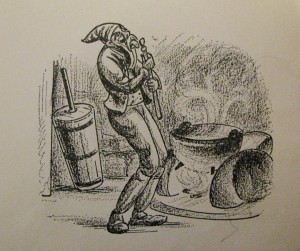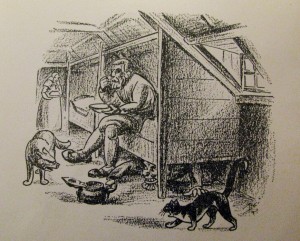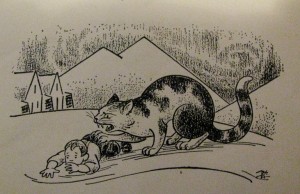Jólasveinar, the Icelandic Yule lads. Posted by hulda on Dec 12, 2012 in Icelandic culture, Icelandic history
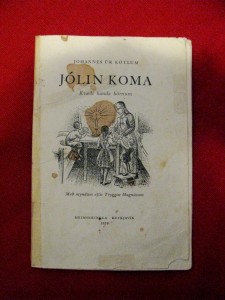 What if there was no Santa Claus but thirteen trolls instead? What if your main task for the Christmas season was not to be good so that you’d get presents but to be good so that you might live through it? What if talk of the Christmas trolls was once officially banned due to their frightfulness? Welcome to Iceland. Gleðileg jól.
What if there was no Santa Claus but thirteen trolls instead? What if your main task for the Christmas season was not to be good so that you’d get presents but to be good so that you might live through it? What if talk of the Christmas trolls was once officially banned due to their frightfulness? Welcome to Iceland. Gleðileg jól.
The origin of the Icelandic Christmas myth dates back all the way to the viking era and Snorri Sturluson, the author of f.ex. Edda, who mentions a fearsome ogress by the name Grýla. Hundreds of years afterwards her description had mostly stayed the same. She was still a magnificent troll lady with 15 tails, except that by the 17th century she had become a voracious man-eater. Her favourite food was stew made of naughty children and to collect enough for a meal she carried 100 sacks in each tail, each sack holding 20 children, meaning that she was capable of eating 30 000 children for a single meal.
According to the legends she was thrice married and gave birth to at least 72 children according to the studies of Árni Björnsson. Of these the 13 she had with her latest husband Leppalúði became her helpers in kidnapping children for her, and her only competition in eating humans was her own cat, Urðarkötturinn. The stories of her and her children eventually became so horrifying that a law was passed in 1746 that prohibited scaring the children with stories about these monsters.
In 1932 Jóhannes úr Kötlum wrote a small poetry book of the Jólasveinar (= yule lads) where he gave a small description of each of the Christmas monsters.I was lucky enough to find a re-print of it, dating from 1970, and all of the photos in this entry are taken from that book.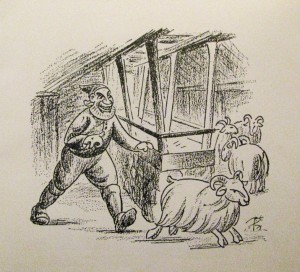
The first one of them was called Stekkjarstaur/Stekkjastaur (= sheep-cote clod). He had two wooden legs or peg legs which may have made him slow to move but he still found all the energy to harass sheep that had been brought in for the winter. Old Icelandic houses were linked to the barn so the sheep running around in panic would be easily heard through the house.
The second one’s name was Giljagaur (= gully gawk). He was described as having grey hair and hiding in gullies, looking for a chance to steal milk.
Stúfur (= stubby) was the third lad and like his name suggests he was very short. He stole pans that had food dried on them and ate the crust.
The fourth, Þvörusleikir (= spoon licker) was abnormally tall and thin as a rake, severely malnourished for his habit of only eating by licking spoons clean. Not just any spoons, mind you, only the long handled ones used for cooking.
Fifth, Pottaskefill (= pot scraper) stole pots to eat what was left in them. The poem by Jóhannes mentions that he had a habit of tricking children to think someone was at the front door and when they ran there to see who it was he stole the pots and ate them clean – sad to be a child who had wished for a bit more food.
One of the creepiest ones was no doubt the sixth Jólasveinn Askasleikir (= bowl licker). See him there under the bed? That was where you’d find him if you were unlucky enough to have him in the house. He would wait there silently until you put your bowl on the floor – as you can see from the picture beds doubled as chairs and putting things on the floor was typical – and then he would reach out from under the bed, steal the bowl and eat everything that was in it. No food for you if you weren’t careful!
If Askasleikir was creepy, Hurðaskellir (= door slammer) was probably the most annoying. True to his name he slammed doors, especially during the night. Several times per night. When you had just drifted off to sleep, that’s when.
Skyrjarmur, or Skyrgámur (= skyr gobbler) was the eighth. You could tell that he had been around if there were finger marks all over the skyr. He’s often described to be a bit of a messy eater and with skyr making an awful mess is easy – just watch some of the videos of Icelandic protests, sooner or later someone flings a skyr at either the Parliament house or the police.
The ninth, Bjúgnakrækir (= sausage swiper) literally stole sausages. He hid in the rafts and at the first chance he got your sausages would be gone.
The tenth must be the creepiest, worse even than Askasleikir. His name was Gluggagægir (= window peeper) and he was described as having enormous eyes. The illustration makes it all the worse because just look at those children, they know being seen by him cannot bode well. Logically enough he’s the worst thief of the bunch which means that originally he was probably the best at stealing food for his mother whose favourite treat – well, you know.
As eleventh, Gáttaþefur (= doorway sniffer) liked to hang around the houses on the outside if someone was making laufabrauð, an Icelandic Christmas treat, and had forgotten the door open. He’s the one with the huge nose!
Ketkrókur (= meat hook) stole meat in a rather curious way – he lowered a hook through a chimney and used it to grab smoked meat that used to be hung from the rafts. Let’s not think too much about how he might have kidnapped children.
The thirteenth and the final one of the jólasveinarnir was Kertasníkir (= candle stealer). In times when candles were still made of fat he stole them to eat them.
These 13 trolls arrived one by one and guess what, today the first one leaves his cave in Dimmuborgir (= dark city, a strange lava formation area near Mývatn) where they are reputed to live. It’s Stekkjastaur, the sheep harasser, and tomorrow his brother Giljagaur the milk thief will follow suit. One by one they arrive until the Christmas arrives and after that, one by one they leave, starting again from Stekkjastaur. The last one to leave will be Kertasníkir, who will leave around Epiphany.
So when the Christmas is finally here and you may be a little hungry for having so much of your food stolen, a little tired for waking up with a start several times a night, a little spooked because weird sounds and coming from the sheep pens, the roof and – what was that shadow that just passed the window? – of course you cannot have much light because for some inexplicable reason you’re almost out of candles, isn’t it still good that you have not become Grýla’s food yet? Well, yes, it’s very nice to still be alive to celebrate the holiday, but do not let your guards down yet. The next one to arrive is
…Urðarköttur (= cliff cat), the pet cat of Grýla. No amount of being good will save you from her. In fact nothing you do yourself can save you if you are on her list. If you received no new article of clothing as a Christmas present she’ll eat you. Unfair? Very. Frightening? Yes! A popular myth to this day? Well… yes, people love this kitty cat. Here’s Björk singing about her. The lyrics are actually the same poem by Jóhannes úr Kötlum that is in this little book I photographed for this entry. They can be found in the info -part of the video so you can try learning to sing it too.
So you better watch out, you better not cry…
More information about the Icelandic Christmas trolls and monsters can be found here:
Grýla (English).
Yule lads (English).
Getting even with Grýla (English).
The painting of Grýla by Þrándur Þórarinsson that has recently become an internet hit. Before you click it I’m warning you all that this is a gory image of her eating a small baby alive, it may be upsetting to look at (Icelandic).
Grýla og jólasveinar (Icelandic).
Hvað getið þig sagt mér um jólasveina (Icelandic)?

Build vocabulary, practice pronunciation, and more with Transparent Language Online. Available anytime, anywhere, on any device.
About the Author: hulda
Hi, I'm Hulda, originally Finnish but now living in the suburbs of Reykjavík. I'm here to help you in any way I can if you're considering learning Icelandic. Nice to meet you!



